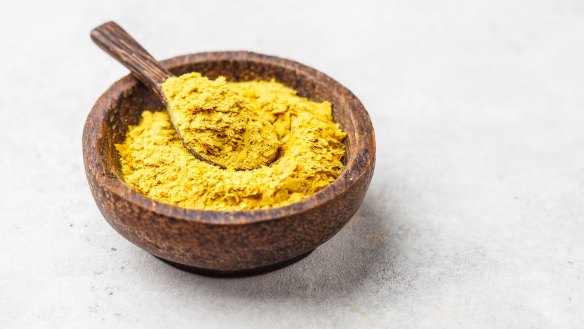The two special diet-friendly seasonings you'll soon be seeing everywhere

Now that vegetarian, gluten-free and lactose-free dishes have graduated from special requests to regular menu items, it follows that once-fringe ingredients that address these dietary concerns are also going mainstream. Two seasonings - coconut aminos and nutritional yeast - have come up repeatedly on my social media feeds recently. They are becoming more and more common - and available in many grocery stores - because they meet the needs of today's eaters.
Here is what you need to know to make the most of these unique ingredients.
Coconut aminos
Coconut aminos is a brown liquid seasoning made from the fermented sap of the coconut palm blossom, which is then seasoned with salt. It doesn't taste like coconut - rather, it is very similar to soy sauce, but it's lighter, less intense and somewhat sweet. Coconut amino's spike in popularity is partly because it's gluten- and soy-free, so it makes an excellent soy sauce substitute for people with coeliac disease, gluten intolerance or soy allergies. It is also considerably lower in sodium than soy sauce, with 90 to 140 milligrams of sodium per teaspoon, depending on the brand, compared with about 290 milligrams for the same amount of regular soy sauce and 162 milligrams for low-sodium soy sauce.
People are also buying coconut aminos because they believe the many false and misleading claims they read about it online, and its popularity has risen with that of restrictive diets such as paleo and Whole30, which allow it but prohibit soy foods. Proponents contend the seasoning is bountiful in amino acids (the building blocks of protein) and other nutrients, and that it lowers the risk of heart disease, diabetes and colon cancer.
None of these claims is fact-based. Though coconut aminos contains the amino acid glutamate, which gives it its savoury taste, it is not a nutritionally meaningful source of amino acids in general. One serving of coconut aminos (one teaspoon) provides zero grams of protein. As for other nutrients, though fresh coconut sap contains vitamins, minerals, fibre and antioxidants, scant - if any - are retained in the processing of the sap into coconut aminos, and there are no studies to back up any disease prevention benefits. Many laud coconut aminos for being MSG-free, but traditionally brewed soy sauce doesn't have MSG either. And besides, though a small per cent of people may be sensitive to the additive, its unhealthy reputation is largely unwarranted.
Some people switch to coconut aminos because they are avoiding soy products out of concern for the food's bioactive compounds such as phytoestrogens. But besides the fact that a couple of daily servings of traditional soy foods is not alarming for most people, soy sauce itself has negligible amounts of these compounds.
So disregard the hyped claims about coconut aminos and consider the ingredient as a good option if you are cooking for people with gluten intolerance, soy allergy, and/or need to reduce their sodium intake. You can use it as a one-for-one replacement for soy sauce - as a dipping sauce, in dressings, marinades and in stir-fry recipes. Just keep in mind that coconut aminos is sweeter than soy sauce. That means it may not be right for every dish, and you might want to reduce the amount of sweetener in recipes that call for added sweetener, such as dressings and marinades. Coconut aminos should be stored in the refrigerator after opening.
Nutritional yeast
Nutritional yeast has long been a flavour and nutrient powerhouse for vegans, though it has mostly been relegated to a lower shelf of the health food store. Now that vegan diets have been knighted by the likes of Beyonce, nutritional yeast is having a moment. It even has a cool new nickname - nooch.
Nutritional yeast is similar to the brewer's yeast used in baking, but it is deactivated through a heating and drying process. Its pale yellow flakes have a nutty, cheesy flavour, so it is ideal for producing such flavour in dairy-free dishes. It's also packed with essential nutrients: A quarter cup of nooch, which has 60 calories, provides more protein than a large egg and is packed with fibre and an array of B vitamins and minerals. It is often fortified with vitamin B12, which is especially important for vegans because this essential nutrient is primarily found in animal products.
Though nutritional yeast is safe for most people, it is not recommended for those with irritable bowl disease, glaucoma and hypertension because it may exacerbate those conditions. And because nutritional yeast supplementation may lower blood sugar, people with diabetes should consult their doctor before adding it to their diets.
Use nutritional yeast whenever you want a hint of cheese flavour in a dairy-free way, adding it to taste the way you might add Parmesan cheese to a dish. It is delicious when sprinkled on warm popcorn, in risotto or on pasta dishes, in mashed potatoes, on cauliflower, and to make vegan mac-and-"cheese." You can stir it into creamy soups, add it to an egg or tofu scramble, or sprinkle it onto toasted garlic bread. It is also makes for a delicious dairy-free dressing similar to Caesar.
You can pick up a jar of nutritional yeast in a health food store (where it is no longer hiding in the corner). If it hasn't shown up in your local grocery store, it should be there soon. Store it tightly sealed in a cool, dry place where it will keep for about a year.
The Washington Post
The best recipes from Australia's leading chefs straight to your inbox.
Sign up- More:
- Health and nutrition